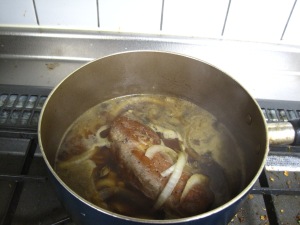 This recipe is quite adaptable. As I’ve written it, this is a vegetarian pasta dish, but you can add chicken as well, and you can change the vegetables to fit what’s in season or on sale. It also includes some protein from the beans.
This recipe is quite adaptable. As I’ve written it, this is a vegetarian pasta dish, but you can add chicken as well, and you can change the vegetables to fit what’s in season or on sale. It also includes some protein from the beans.
Ingredients (serves 2 with leftovers)
1 tbsp olive oil
1/2 onion, sliced thinly
2 cloves garlic, minced
700mL (3 cups) vegetable broth (chicken broth is okay too)
200g dry penne pasta (1/2 lb)
1 cup cooked white beans
1-1/2 cups vegetables (broccoli, asparagus, and spinach or a mixture are all great)
125g (4 oz) sun-dried or salted tomatoes
120mL (1/2 cup) cream (in Japan, I use 35% cream)
1 tsp lemon juice
salt and pepper to taste
grated Parmesan cheese for serving
Instructions
Heat olive oil in a frying pan over medium heat. Saute onion and garlic until softened. Add vegetable (or chicken) broth and pasta. Bring to a simmer.
Cook pasta for the time directed on the package, plus 2 minutes, stirring occasionally. If too much liquid evaporates, add a little more water. With five minutes remaining, add the tomatoes, beans, and vegetables and stir.
After the pasta finishes cooking, add the cream. Stir and cook until the cream thickens into a sauce. Add lemon juice and salt and pepper to taste.
Serve with Parmesan cheese.








